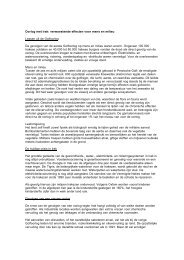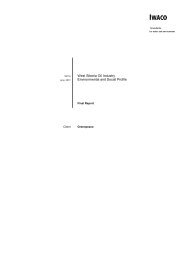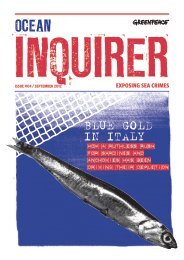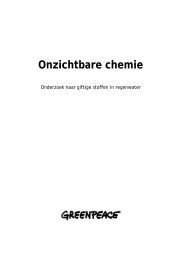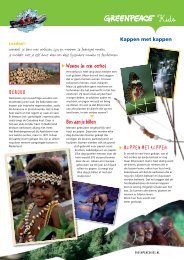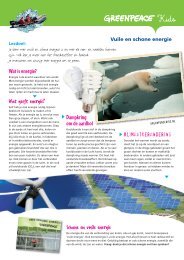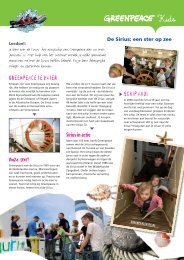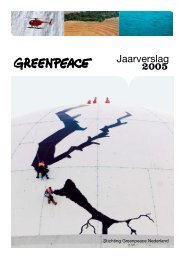man-made chemicals in human blood. levels of - Greenpeace ...
man-made chemicals in human blood. levels of - Greenpeace ...
man-made chemicals in human blood. levels of - Greenpeace ...
Create successful ePaper yourself
Turn your PDF publications into a flip-book with our unique Google optimized e-Paper software.
Materials and methods.<br />
Before the start <strong>of</strong> the project, all methods used <strong>in</strong> this study were validated for the analytes under study.<br />
The validation experiments were carried out us<strong>in</strong>g fresh calf’s <strong>blood</strong> and spiked with the analytes <strong>of</strong><br />
<strong>in</strong>terest. The validation study resulted <strong>in</strong> standard operation procedures that were tested on a limited<br />
number <strong>of</strong> hu<strong>man</strong> <strong>blood</strong> samples and subsequently used <strong>in</strong> this study.<br />
Sample pre-treatment.<br />
Upon receipt <strong>of</strong> the whole sample, a sub-sample was collected for the organot<strong>in</strong> analysis. The rema<strong>in</strong><strong>in</strong>g<br />
part was allowed to clot at room temperature for 20 m<strong>in</strong> and centrifuged at 4000 rpm for 15 m<strong>in</strong>. The<br />
serum was transferred <strong>in</strong>to PTFE-capped glass vials and stored at 4°C until further analysis.<br />
Sample analysis. Extraction <strong>of</strong> serum samples.<br />
All glassware used <strong>in</strong> the analyses was cleaned, r<strong>in</strong>sed with deionised water and baked <strong>in</strong> an oven for 16<br />
hours at 280°C prior to use. All solvents were distilled prior to use to achieve low blank results. The<br />
latter was especially important for the determ<strong>in</strong>ation <strong>of</strong> the phthalates.<br />
The serum sample was weighed <strong>in</strong>to a clean glass 60 ml vial. Methanol, 0.1 M HCl and a set <strong>of</strong> <strong>in</strong>ternal<br />
standards (one or more for each group <strong>of</strong> <strong>chemicals</strong>) was added to the sample. The sample was extracted<br />
twice with a hexane-diethyl ether mixture and centrifuged to separate the organic phase. The comb<strong>in</strong>ed<br />
extracts were washed with a 1% KCl-solution and dried with anhydrous sodium sulphate. The extract<br />
was split <strong>in</strong>to two equal parts, A and B.<br />
Bisphenol-A, tetrabromobisphenol-A, alkylphenols and alkylphenol ethoxylates.<br />
Part A <strong>of</strong> the extract was concentrated to a small volume without further purification. Methanol was<br />
added to the extract and the extract was concentrated further to remove all hexane-diethyl ether residues.<br />
The methanol extract was used for the determ<strong>in</strong>ation <strong>of</strong> BPA, TBBPA, NP, OP, NPEO and OPEO. The<br />
f<strong>in</strong>al extracts were analysed with liquid chromatography coupled with mass spectrometry (LC/MS) <strong>in</strong><br />
the selected ion monitor<strong>in</strong>g mode (SIM).<br />
Brom<strong>in</strong>ated flame retardants, phthalates and musk compounds.<br />
Part B <strong>of</strong> the extract was concentrated to a small volume. The extract was purified us<strong>in</strong>g a florisil cleanup<br />
procedure and separate fractions were collected conta<strong>in</strong><strong>in</strong>g the component groups. The purified<br />
extracts were concentrated to a small volume and an <strong>in</strong>jection standard was added. The f<strong>in</strong>al extracts<br />
were analysed with gas chromatography coupled with mass spectrometry (GC/MS) <strong>in</strong> the selected ion<br />
monitor<strong>in</strong>g mode (SIM).<br />
Organot<strong>in</strong> compounds.<br />
The whole <strong>blood</strong> sample was weighed <strong>in</strong>to a 60 ml vial and <strong>in</strong>ternal standards were added. After the<br />
addition <strong>of</strong> a sodium dithiocarbamate solution <strong>in</strong> ethanol, the sample was sonicated, left overnight, and<br />
sonicated once more. The residue was removed and an acetate buffer and a sodium tetra-ethylborate<br />
solution <strong>in</strong> ethanol were added. The mixture was extracted twice with hexane for 30 m<strong>in</strong>utes and<br />
purified us<strong>in</strong>g a silica clean-up procedure. The purified extract was concentrated and an <strong>in</strong>jection<br />
standard was added. The f<strong>in</strong>al extracts were analysed with gas chromatography coupled with mass<br />
spectrometry (GC/MS) <strong>in</strong> the selected ion monitor<strong>in</strong>g mode (SIM).<br />
Identification, quantification and expression <strong>of</strong> results.<br />
The identification <strong>of</strong> analytes was based on correct retention times and qualifier ion ratios, compared to<br />
an external standard. The quantification was based on an external standard analysed together with the<br />
5



